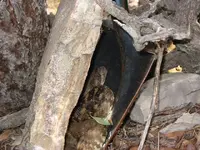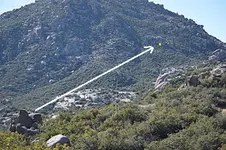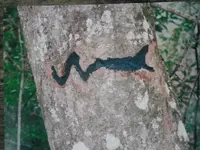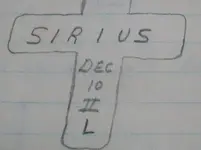Crosse De Sign
Gold Member
- Joined
- Jun 19, 2013
- Messages
- 5,808
- Reaction score
- 5,903
- Golden Thread
- 0
- Location
- ~: Hell And Back :~
- Detector(s) used
- White's MXT ~ TM800 ~
- Primary Interest:
- Other
View attachment 1570467
So look at the two Royal Poodles, then look up and to the right, along the spine of the mountain. See the window? The big pointer, which is actually a Royal Poodle nose, is pointing the way out, down to a huge spring and giant cottonwood trees that used to be there. Approx. 80% of the wetlands are now gone, since 1540. To follow these trails, there is a lot of reconstructing the landscape that needs to be done. It is not anything like it used to be. I read one account of the Spaniards coming into a beautiful valley with grass up to their stirrups, and a huge river, everything they needed to regroup and rest. I found it, and today it has very little grass, if you can find any, thick gnarly brush filling the entire valley and mountain sides, and the river is a small stream, part time. The cattle grazing, or over grazing I should say, destroyed many beautiful habitats in the south west. They brought in too many cattle for the land to support, they ate all of the grass, then all of the brush, then spread the seed from the brush all over the landscape, and that is what you have today. Then, after long and concentrated exploration of 5 or 6 definite sites, I will tell you that someone, back in the 1800's and early 1900's, knew about the monuments and how to follow them. I don't claim them to be the KGC, or Jesse James, or anyone in particular, however, there were Spanish Treasure Hunters way before we came on the scene. We found some old stuff, from the 1800's, in one the the shafts that was resealed and most of the really important monuments were destroyed. The only hint is a cross chiseled in the rocks, and a Turtle that is very hard to recognize. It may have been the Mexican Treasure hunters. Whoever it was, they explored far and wide. They found a lot of sites that the hunters of today are wasting their time trying to find again. If you want to find the good ones, be prepared to risk it all.
Another thing, see the front of the Poodle Monument, and you will see a guy reclining, as if he is asleep...that's me, the tired old Irishman.
All very interesting, seems you've done a lot of work, ah yes, too bad
about good 'ol Father Time, for all of us that are adventurous at heart.
Still, the sure fire way that sandy1 has revealed, & even proved by
doing the field work step by step live time, is using the markers &
alignments, and particular camera(s) to capture the aura put off by
the sun's radiation interaction with the minerals.
Now that's a remarkably awesome time saver, everyone should try...
Good Luck, stay young at least in spirit, be safe, that rattler looked
pretty mad at you, ready to spring several feet. I have a good set of
Kevlar snake guards I bought on a trip out west, that I've never worn.
I am planning to however, since I don't want me luck to run plum out.
Last edited:












